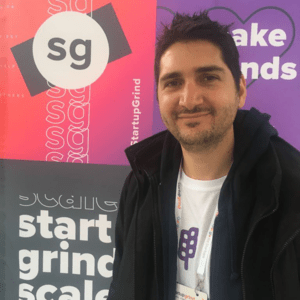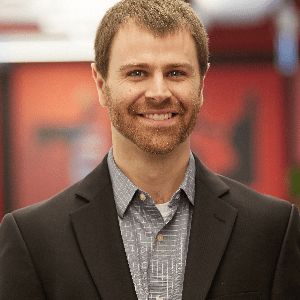As VP of Growth at EuroVPS, I had to make a LOT of decisions, daily. This got exhausting, especially if I had multiple good ideas on how to do something, but wasn’t sure which to choose. Moments like these inspired me to build GrowthMentor. Does this resonate? If so, I’d love to try and help you.
What would you do: Growth stalls at $50k MRR
About this episode
In this episode, Foti and Ryan Gibson talk about what startups should do when their growth stalls.
The specific hypothetical scenario circles around a SaaS company that's stalled at $50,000 MRR.
What would Ryan do to break out of the plateau?
Listen to the episode to find out.
What they talked about:
- Using customer research to cut through the fog of "what are we doing right now?"
- Who should be responsible for doing user research
- Figuring where the drop-off in growth is happening
- What questions to ask during user research calls to inform acquisition and retention optimisation strategies
- Being honest with yourself. Are you really mission-critical anymore?
And all this in less than 18 min!
Transcript
Foti Panagio: Awesome Ryan! Thank you so much for joining us. In this episode, we’re going to play the what would you do in this scenario, if you’re a startup founder or marketer needs for all the stalls $50,000 MRR spend on for the last four or five months, and you’re trying so many different things, all the different growth tactics stones are beginning of the wall to see what kind of stick and nothing’s really moving the needle. The last time the company did a proper customer discovery initiative was like a year and a half, two years ago. Right. So they’re like, all we should talk to the customers again. So I mean, that’s, that’s that’s where they’re at? I mean, what would you do in that situation? You already know the value of customer research. Right? You’ve got traction, there’s product market fit, or, you know, a semblance of it. But things kind of slow down.
Ryan Paul Gibson: Yeah, it feels like a game show title. Would you do like it? I mean, I think it’s like, if I can back up a bit, I think it’s tough because sometimes we just get lost in the daily on goings of the business. Right. And it’s really, I’ve been doing this now for almost two decades. And so easy to get lost sometimes in like, the processes of the day to day things without understanding, like what you’re doing is actually worth your time and resources. And there’s a few ways to do that. But yeah, I like, for me, customer research is one of the best ways to sort of cut through the fog of like, why are you doing what you’re doing? So, you know, how I would probably do that is I would look at a few things. So I’d want to understand, you know, if we have an ideal customer, what’s happening to them? Is a challenge that they’re not less are coming in, or maybe more turning right now. Right? Could be either one, right? It could be both?
Foti Panagio: Could be both.
Ryan Paul Gibson: Yeah. So you want to isolate sort of like, what part of the equation of relationship do you want to focus on first. Like, where do you think the the worst bleeding is? That’s a graphic visual, but you know, lack of a better term. So you know, let’s just say it’s not enough of the right people coming in. Right? So we’ll often call it like an ideal client profile, or you know, set our best customers or what have you, right. So I wonder if say it’s we we isolate that that variable? Well, then we want to figure like why that’s happening then. Right? And where are they dropping off and why? So I often what I’ll try to what I try to do in my work is if I’ll try to understand like, why and how they’re making decisions, and then choosing us out of certain products and choosing us over all those other decisions that exist. So for example, you know, I worked with a SaaS company recently where they actually acquired a company, and exactly seemed to happen, like the revenue didn’t track to where they had forecasted. It was starting to flatline so that we wanted to go and talk to users and possibly users, but like, you know, this is what we do. But I wonder, say more about, like, whether this is important to you, how you do these sorts of things already. What how do you evaluate those products? And then how do you decide upon us or decide on the solution that you chose? Because if you can understand that path, then you can actually influence people’s decision making at various steps towards that purchase? Hope I explained that. Okay.
Foti Panagio: Yeah, totally. Yeah. So basically understanding why, why he would, why they do what they do.
Ryan Paul Gibson: Yeah, I mean, there’s so much that happens in a business. But why they choose the solutions they do, whether it’s a SaaS product, or a vendor to work with, whatever, like, the caterer they have for their townhall meetings, like whatever, like there’s all these rationales we make that happen even way before he decided to enter into an agreement. But what’s happened in the business that’s that those problems exist in the first place? Or who’s involved in the decision? Like, what are they evaluating? What do they care about? How are what information are they using to make that decision? Because then if I know all that, and my hypothesis is that we’re not getting enough of the right people. Maybe it’s because your messaging is off. Maybe it’s because your position isn’t right. Maybe it’s because you’re marketing the right channels. Maybe it’s because they’re evaluating other solutions. And the other solutions have a better job at positioning. You know why they can solve the problem better? I’ve even heard it’s really interesting that, you know, I work as a researcher, I’ve heard this one thing in the last little while in sales lead companies, where the sales director will say we’re always behind in deals. And what that means is to them, they’re getting shortlisted just as a way to like have an extra option they can bring to all the decision makers, they’re not choosing this solution, they just need another one. Right. So what they’ve done is they’ve actually decided on some other solution way earlier on, but since since they can’t sole source, they’ll go to company X, and that’s the sales director that I’m talking to. And they’re just sort of get added on to that shortlist. And that’s like, so they’re always behind in deals. Right. So those are things that like, those are signals that okay, well, why is that happening? So that’s what that’d be my recommendation, if that is where you think the issue is, if it’s churn? That’s a totally different conversation. Right? Then it’s like position for
Foti Panagio: A little bit, right? Because, yeah, some good points about finding out what the motivations are.
Ryan Paul Gibson: Yeah, absolutely.
Foti Panagio: The audience already knows the basics of user research calls. So let’s dive right into a couple of more specific things. What are some of the core flexible questions that you tend to use more often than eyes? To really dive into that?
Ryan Paul Gibson: It depends on what we want to understand. Right? So if acquisition is it, I want to focus the questions very much on that initial trigger of what happened in a business. That said, they said, Okay, this is annoying. Maybe we should actually find a way to account for this problem, right? Because not all businesses go out to solve something as soon as they identify a solution. Let me give an example. Like, everyone knows HubSpot. But as soon as you start a company, you don’t always use their CRM, right, you eventually graduate into a solution like there’s right or you might use something smaller and then graduate to them. Right. So there’s, we don’t always just because we identify pain doesn’t mean we’re gonna go out and solve it. I’ve talked to customers that are aware of solutions they like and want to eventually purchase for like two or three years. But they had other priorities, because there’s other prior competing priorities and their business for that budget. So that to your question. I like to understand things along the lines of how they’re moving from different stages of consideration. Yeah, so if they’re just, if it’s just the beginning, and they’re like, oh, or data is a mess. I’m like, Okay, well walk me through the whys. What’s happening in the that the data is a mess. What are you using? Oh, we’re using spreadsheets. Interesting. Why are you using that? Oh, well, it’s it’s cheapest. Okay, and I’m just gradually trying to figure out, why is that happening in the business? And what is it about their business that this is the solution for them right now. And then as they go to the next phase is things like, Okay, walk me through the day decided to start actively seeking something to solve this data management problem? What did you do? What was the first thing you did? And then I’m actually starting to see the actions they took, as opposed to caring about, like, their opinions on what what tool is best or not, I just wanna see what they did. Right? And I’ll gradually take them to every stage of a deal, right? If we’re talking about the evaluation process, from a sales perspective, say they’re actually talking to the company, and it’s getting time to them to actually decide who they’re gonna go with. I’ll ask things like, what made you trust us? You know, how did you decide we were the right choice? What do we do to convince you? Things like that, and you’ll get really good insights into like, what you’re doing well, and where you might be falling down?
Foti Panagio: Yeah. Right, right. Well, I like the last. What did you. What did we do to convince you? Yeah, I always like to ask as well, the opposite of what apprehensions what apprehension is that you have.
Ryan Paul Gibson: Oh, yeah, I’ll ask like, what was what? What did we do that didn’t put that wasn’t believable? What what seemed like a lie? Or like what seemed like a stretching the truth, right, the inverse of that eye exams get very poignant about it. Because I want to, I want to see what they say. Because a lot of times in those in those contexts when we’re buying something, we don’t always give our entire thoughts about a process. But in a research exercise, when I do this type of work, when they’re probably already a customer that like product, they’re actually very forthcoming about like, what they actually thought at that point. They might not remember everything, but they’ll give you a lot more than someone who’s not actually going through a sales process.
Foti Panagio: Yeah. Let’s, let’s switch gears to retention.
Ryan Paul Gibson: Yeah.
Foti Panagio: My experience, that’s the number one killer of growth.
Ryan Paul Gibson: Yeah. You know, it’s funny, I do less churn. I know there’s another growth mentor, Anita, she does she used to work the Churn Crusher, right. Yes. Yeah. So she’s the expert to talk to you on this. But a lot of it’s the same thing, right? It’s understanding, you know, if someone did churn and that’s you’d probably want to talk to, they’ll, they’ll talk. Sometimes it’s like, a closed loss interview, we’ll call that it’s not exactly the same thing. But it’s, you know, someone left? Yeah, well, why? Right. And I want to understand it, some of it is exactly the same type of work that I’m doing, that I just talked about, or it can be along the things along lines of understanding that we may read and the written feature, maybe they’ve outgrown the product, that just doesn’t make sense for their business anymore. And that’s okay, so maybe that’s a new opportunity for us to move into up market, as we always like to, everyone always wants to do you know, maybe it’s pricing. Right, maybe we’re maybe we’re a nice to have, as opposed to a need to have, which is such a key. A key one to understand, especially right now where, you know, recession, the word recession is everywhere. And people are very concerned about how much like whether we’re going to be sticking around for our customers, right? That’s like a really good one to know, am I mission critical to their business? Or am I just Oh, yeah, this helps. Those are two different, very, like, those statements are very drastically different. Right? So those are the types of things that I’d want to truly understand about retention, like, what what can I do to keep you around? What do you need? What’s missing? The caveat I’ll put there though, is, it can be very easy to start building everything under the sun for customers. And you have to do an analysis of like, what’s actually worth your investment in your time? Because if only one two people out of 12 are requesting a feature? And they’ll say, oh, stick around because of that. Is that worth your time? I don’t know. You have to make sort of a business decision there. But those are the things I would look at for retention.
Foti Panagio: I recently did 50 user research calls?
Ryan Paul Gibson: Oh, wow! That’s a lot.
Foti Panagio: It 15 minute 15 minute. Action facts. Interesting. One, one of the biggest takeaways, was I got a much clearer idea. Not only who our ICP really is, but who are like bad fit customers.
Ryan Paul Gibson: Yeah.
Foti Panagio: Certain insurance when we buy it?
Ryan Paul Gibson: Yeah, absolutely. That’s it too, right? There’s some people you don’t want around, because there’s a cost of servicing them. Right? Especially if you have a SaaS company, there’s a cost of storing their data, there’s a cost of maintaining everything, like nothing is free. Right? So you want the customers are gonna actually going to stick around and keep using you and our power users and champions, right? You want to understand that too. Because if you can understand that you can find more than on the other side of the equation.
Foti Panagio: For sure, I think that wraps it up, Ryan.
Ryan Paul Gibson: Okay.
Foti Panagio: Any any other.. one final question I have.
Ryan Paul Gibson: Yeah, for sure.
Foti Panagio: So we said this scenario, right? Growth assaults. We shouldn’t be doing this user research calls my opinion, it should be the founder. But, you know, some other people say should be the marketer, because they’re on the front lines of acquisition.
Ryan Paul Gibson: Yeah.
Foti Panagio: Your perspective? I mean, what’s, what do you see working best from from an in house perspective? You know, not not only standard agencies and third party consultancies?
Ryan Paul Gibson: Yeah. I think the two the two ways of looking at it, look at it as it’s like, what resources do you have, based on where you are and your stage of growth? Founder are always such a vital piece of the puzzle at the very beginning of any type of company, right? Because you have the idea and the vision, you sort of have your finger on the pulse. So if there is no one else that can sort of get into the head of the customer and figure out what’s going on why and what the direction the company needs to go in. I think the founder is a good choice, the beginning and eventually and probably that role will get redefined as the team grows and you have to they have to do more things and become more administrative and is coach, you know, player coach as opposed to or full time coach as opposed to like in the weeds. When it gets to that point. How I always look at it as, I think whoever the research, whatever job function, or whatever department, the research, impacts, those people should be spearheading the research. So what I mean by that is, if it’s if you have a SaaS product, your product lead growth, people are in it all the time, and you’re trying to build the stickiest thing in the world. It should be the product people really at the end of the day, because they’re going to when they ask questions, and then hear responses, they’ll start thinking in the context of how they do their job, and how, what their objectives are. For me, as a marketer, I think marketers should do their own research. Because, you know, I can listen to sales calls all day, those are great. Customer Success can give me a giant persona of an ICP, awesome. But I am going to go and ask questions that really impact how I do my work. So I’m going to ask questions in the context of a marketer about how people discover things and make decisions way before they decide to hand over their credit card information, right? Or, you know, sign a contract. So I think the founder is the best person the beginning. But as the team grows, I think you need to determine what do we want to know? And based on what we want to know, whoever it impacts? Those are the people that should lead the research. I hope that makes sense.
Foti Panagio: Yeah, so the way I understand it, is that there should be different trigger points, recessions, different phases. I’m sure you’re saying when you mentioned before the credit card, I assume you mean just like user research. In wild and other.
Ryan Paul Gibson: Yeah, like I do a lot of marketing research was called different things marketing discovery, buying journey research. I lean into a lot of the jobs to be done stuff. But I’m really just trying to understand how businesses and then the people within those businesses are making decisions about the products they’re looking at, and how they’re evaluating these trade offs leading up to a sale. Right, because that’s where marketing tends to live, and is effective, right? How the marketing unfolds. That is much different because every company has a different go to market strategy. But that’s who I think for that exercise should do the work.
Foti Panagio: Awesome. Ryan, thank you so much.
Ryan Paul Gibson: Hey, thanks for having me. Yeah.
In this episode


I help B2B marketing teams run customer research interviews that don’t suck 🕵️♂️. We also uncover content, campaign and copy ideas so teams can spend marketing $$$ wisely; not wastefully.
Join the community
Enjoy the peace of mind that advice is always only one Zoom call away.


